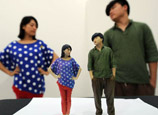
Most whole wheat bread sold in the city doesn't contain whole wheat flour due to a lack of national standards, a clinical dietician told Shanghai Daily.
"Some whole wheat bread sold in the city is made with common grains, not whole wheat, and producers dye them with caramel pigment to make them look brown to cheat consumers," said Wang Xingguo, a clinical dietician. "The common grains also provide a smoother texture, which is preferred by most Chinese customers."
He added some consumers don't like the coarse texture of genuine whole wheat bread, thus some businesses have cut costs by eliminating the use of whole grains.
At a Hualian chain store on Dagu Road, a Shanghai Daily reporter found a package of so-called whole wheat bread priced at 10 yuan (US$1.6) made by Shanghai Taoli Food Co Ltd. It didn't contain whole wheat flour. The listed ingredients were wheat meal flour, milk powder, cream, sugar, salt, water, yeast and additives.
Whole wheat foods are becoming more popular among residents as they contain a variety of vitamins, minerals, along with fiber and phytochemicals.
Nutritionists say whole wheat bread is healthier because it can help prevent cardiovascular and cerebrovascular diseases and diabetes.
Wang said the amount of whole wheat used to make bread is determined by producers because there is no national standard.
Some businesses add bran or wheat germ instead of whole wheat, he said.
Whole-wheat bread is made using flour that is partly or entirely milled from whole or almost-whole wheat grains. Recipes for whole wheat breads vary considerably.
















 Breathing and Working Together:Mobile app tells you Beijing's environment
Breathing and Working Together:Mobile app tells you Beijing's environment


![]()
